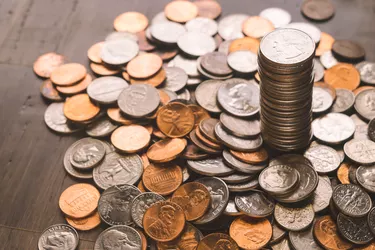
Rolling coins makes it easier to store them and to deposit or exchange them for bills at the bank. Save money by rolling coins at home instead of relying on coin-counting machines that charge a percentage of the total. Rolls typically show the dollar amount of the coins and denomination, such as $5.00 dimes, making it easy to add the total when finished.
Divide and Conquer
Video of the Day
Choose the right surface so rolling coins is easier. Try your bed, since it's soft, flat and has a large surface. A hard surface, like a table, may lead to coins rolling away while you're working. Dump the coins on the bed and begin sorting by denomination. This helps in two ways: you can see which denominations have enough coins to roll and you can roll quicker since you don't have to sort coins as you go.
Video of the Day
Gathering Enough Coins to Make a Roll
Pile your coins in groups of 10 for easy counting. Don't bother stacking them in columns since they may just fall over and mix with other fallen columns, costing you time as you recount and stack. No matter what kind of roll you use — paper, bank wraps or plastic — the amount of coins in each wrapper will be the same.
There are always 50 pennies in a roll, for a total of 50 cents. Forty nickels are rolled together for a total value of $2, while 50 dimes in a roll equal $5. Quarters are always in rolls of 40, totaling $10. Half dollars are rolled in groups of 20 for a total of $10 per roll. U.S. dollar coins are rolled in groups of 20 for a total value of $20, while small dollar coins, like presidential dollars, are rolled in groups of 25 coins totaling $25.
Wrapping Your Coins
You have a choice between paper wrappers and plastic coin rolls. Plastic rolls hold their shape and can be easy to fill, though you may have to add a strip of tape to keep them shut since they don't always seal properly. Flat paper wrappers are usually provided free by banks for their customers. Visit your branch and ask for wrappers before spending money to buy them.
Choose the right denomination and open the paper wrapper by pressing on the creases and folding them flat for four evenly spaced creases. Next, open the roll again and create a rough circle at one end. Large hands are an advantage since you can hold a whole line of coins in one hand. If you have smaller hands, try half a roll at a time. Hold your counted stack of coins in one hand and hold the wrapper in the other.
Be patient — with practice you'll be able to pour your line of coins in the wrapper without any coins turning sideways partway through.
Taking Coins to Your Bank
If you were planning on taking your coins anywhere other than a bank where you have an account, it's unlikely you'll be able to exchange your rolls for cash. So you'll probably have to visit your own bank to deposit or exchange your coins. Rolling your coins ahead of time can save you a service charge since some banks charge a processing fee for loose coins.
You might also want to call your branch ahead of time to ensure that there isn't a limit on how many coins you can exchange without facing fees. If you're required to write your name and account number on each roll, ask if your bank destroys the wrappers. You don't want a stranger receiving your name and account number the next time someone asks for a roll of coins.